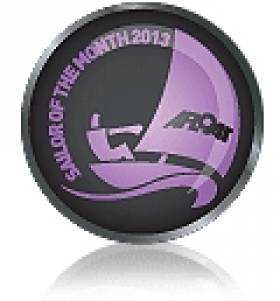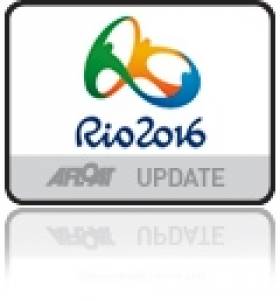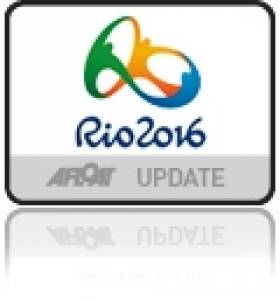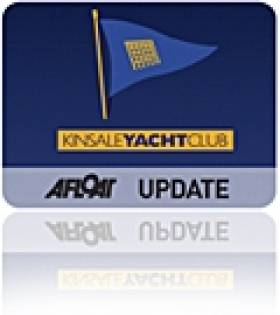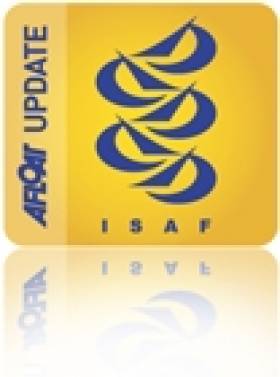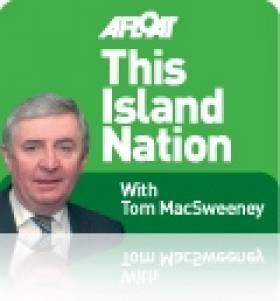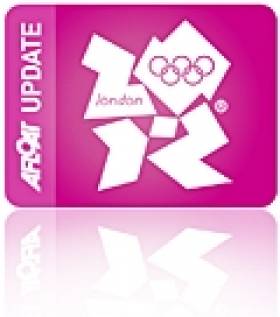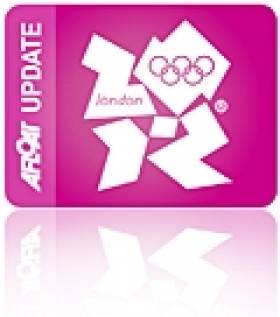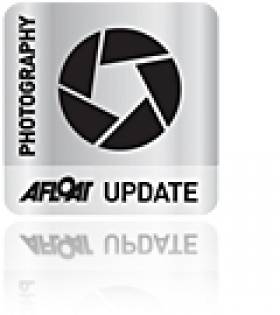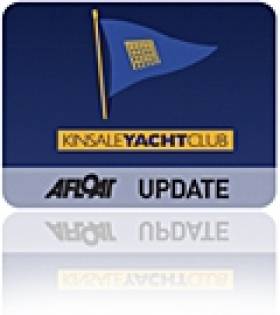Displaying items by tag: John Twomey
Paralympic Helmsman John Twomey is Sailor of the Month
#sailorofthemonth – The summer of 2013 has been the season in which world sailing has come to Ireland. In addition to two World Championships, events such as the Volvo Dun Laoghaire Regatta and the Sovereigns Cup at Kinsale have brought sailing visitors to our shores. Then too, being a Rolex Fastnet Race year, 2013 saw a fleet of record-breaking size rounding our most famous rock, an event in which a dozen Irish boats took part.
The events which were staged from Irish ports involved an enormous amount of voluntary effort from our own communities, large and small. And skilled effort at that. Well-meaning willing helpers can be a mixed blessing. But when experienced administrators build up their chosen team of specialists as the allotted time of each major event approaches, the effective administrative machinery - virtually guaranteed when Ireland is hosting a big event - slips smoothly into place.
After such a summer of so much success in event management, there are many volunteers whose efforts deserve to be highlighted. So in making John Twomey of Kinsale the Afloat.ie "Sailor of the Month" for August, we hope that other organisers will realise that we are applauding their efforts too.
But amongst the elite of organisers, John is the crème de la crème.
An active participant himself to Olympic level, his election last November as President of the International Association For Disabled Sailing was a well-earned indication of the high regard in which he is held in global sailing. And in bringing the Worlds to his home port and ensuring that it was a success which was popular with the general public too, John Twomey played a unique role, deserving of national recognition and celebration.
#IFDS – On the eve of the International Federation for Disabled sailing (IFDS) World Sailing Championships being staged in Kinsale, County Cork next month, its President, Irish Paralympian John Twomey, has warned of the potential bankruptcy of the world body arising out of substantial legal costs incurred in an action over the results of the Sonar class at the London 2012 Paralymics.
Writing in the association's latest newsletter Twomey, who became IFDS president at last November's ISAF world sailing conference in Dublin, says the costs involved are 'a major problem for IFDS as we do not currently have sufficient funds to pay for the fees and costs incurred without third party assistance'.
Twomey goes on to say 'the insufficiency of funds could in turn lead to the Executive Committee having to place IFDS in bankruptcy'.
IFDS met with ISAF in London on 2 July 2013 to discuss the possible integration of both organisations. The situation is ongoing, according to the Kinsale based President.
In the recent case, Twomey writes the Arbitrator upheld IFDS's initial contention that CAS lacked jurisdiction in this case and the result of the Sonar class at the London 2012 Paralympic stand. The arbitrator also ruled that the British Paralympic Association (BPA) must reimburse the other parties for the substantial fees paid to CAS, but that each party must pay its own legal fees and costs. In addition to legal fees, IFDS has incurred substantial costs for witness travel and other expenses.
To date entries have been received from 19 countries in the One-Person Keelboat, 2.4mR; 4 countries in the Two-Person Keelboat, SKUD18 and 12 countries in the Three-Person Keelboat, Sonar for the IFDS world championships to be held at Twomey's home waters of Kinsale in August.
Separately, this week the Irish Paralympic team signed a four year sponsorship deal with Providence Resources for the Rio Games.
Kinsale Salutes Twomey's Paralympic Sailing Achievements with IFDS World Championships
#ifdsworlds– Kinsale Yacht Club (KYC) in County Cork has launched the first major Paralympic event following London 2012 with 120 disabled sailors from 20 countries expected to attend the International Federation for Disabled Sailing (IFDS) World Championships for 2013 in the south coast town this Summer.
The August event will see three paralympic classes take to the waters of Kinsale harbour; the Sonar three person keelboat, the Scud 18 two person keelboat and the 2.4mR single person keelboat.
Teams from China, Japan, Singapore, Australia, USA, Canada, Brazil, UK, Germany, Italy, France, Greece, Austria, Poland, Norway, Israel, Holland, Portugal and Ireland are expected to attend.
As previously reported on Afloat.ie, Kinsale Yacht Club member John Twomey, a paralympic competitor, is the driving force behind the event.
"I have received so much support from Kinsale and the sailing community over my years of Paralympic competition. It gives me great pleasure to host this event as IFDS President in my home waters".
Twomey has participated in 10 Paralympic Games, more than any other Olympic or Paralympic athlete, was elected President of the International Federation of Disabled Sailors at the ISAF (International Sailing Federation) conference in November 2012. Twomey may still yet campaign for the Rio paralympics in 2016.
Kinsale bid for the event in 2010 against stiff competition from Perth in Australia and Qingdao in China. This is the first time that the IFDS Worlds are being hosted in Ireland. The organising committee, under the direction of Regatta Director John Stallard, has been developing plans since they were awarded the event in 2010.
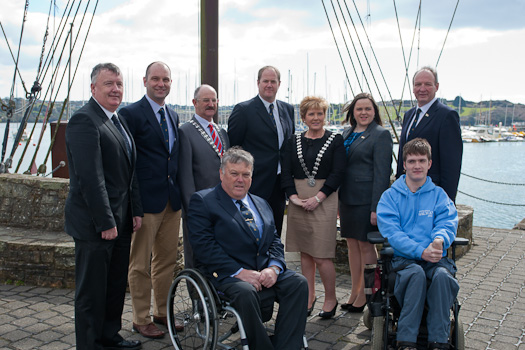
Launching today's IFDS World Championships in Kinsale, County Cork were back row (left to right) Ger Power, Cork County Council; Matthias Hellstern, Kinsale YC; Billy Lynch, Mayor of Kinsale; Cameron Good, Commodore of Kinsale Yacht Club; Barbara Murray, Mayor of Cork County; Janice Twomey (John's daughter); John Stallard, KYC. Front row John Twomey, Kinsale Paralympian and Sam McCarthy, Irish Access Sailing Group. Photo: Bob Bateman
Cork County Council is supporting the Worlds which is one of only three World Championships leading up to the 2016 Paralympic Games in Rio de Janeiro, Brazil.
Speaking at today's launch Mayor of County Cork, Cllr Barbara Murray stated "Cork County Council is delighted to support this major international event in 2013. As part of Cork County Council IFDS Worlds, Kinsale is being marketed internationally as a major tourism and sailing centre of excellence and we look forward to welcoming all the sailors and support teams to a fantastic 10 day event in August".
In addition to the sailors, Kinsale also expects to welcome 300 support staff and family to Kinsale and a full social calendar including a parade and civic reception has been planned.
Kinsale is no stranger to major international events including the Dragon Gold Cup, the biennial Sovereigns Cup, the Figaro single handed race and the Clipper Round the World Yacht Race. Kinsale Yacht Club is currently undergoing major refurbishments in preparation for this year's season.
Disabled Sailing World Championship Heading for Kinsale
#disabledsailing – Kinsale in County Cork launches this summer's International Federation of Disabled Sailing (IFDS) World Championships on Friday.
It's a proud moment for local sailor John Twomey. Not only is he a former commodre of the host club but he's also Ireland's most capped Paralympian and current president of the IFDS.
Kinsale Yacht Club will host the 16-nation event from 22nd to 25th of August 2013. All three paralympic fleets be racing with participating sailors expected from more than 16 countries.
Ten time paralympic sailor Twomey is the new President of the International Association for Disabled Sailing (IFDS).
Twomey was elected at the International Sailing Federation (ISAF) Annual Conference in Dun Laoghaire, Co. Dublin last November. The honour came two months after he competed at his tenth Paralympics in Weymouth, a record for any Irish person competing at either the Olympics or Paralympics.
The launch is expected to announce event sponsors and other plans for the event.
Kinsale Paralympian Leads World Disabled Sailing Body
#paralympics – Ten time paralympic sailor John Twomey is the new President of the International Association for Disabled Sailing (IFDS).
John was elected at the International Sailing Federation (ISAF) Annual Conference in Dun Laoghaire, Co. Dublin at the weekend. international The honour comes two months after John competed at his 10th Paralympics in Weymouth, a record for any Irish person competing at either the Olympics or Paralympics.
John will serve a four year term as head of the organisation responsible for sailing for people with disabilities worldwide.
Rambler Crew Thankful, A Story of Two Vessels, Our Paralympians and Cork's New Pilot Boat
The Rambler Crew thank Valentia Radio for saving their lives in the Fastnet Race, but Coast Guard management wants to shut the station .... My story of two vessels ... John Twomey's Parlaympian achievements ... Cork gets a new Pilot Boat and ... trying to make ship-boarding pilot ladders safer ... There's a lot about boats in this week's TIN ..... Read on ....
SAVING LIVES MATTERS MOST – NOT FINANCIAL CUTBACKS
August 15 this year marked a very special day for the crew of the yacht Rambler 100 – they were still alive and they celebrated that fact – and they sent from New York an Email to the staff of Valentia Radio Coastal Station in Kerry. Coast Guard management in Dublin has a proposal to shut down the station and transfer its work to Dublin, to the constituency of the Minister for Transport, as a support station to the main Dublin base!
On August 15 the Rambler 100 crew Emailed to the staff at Valentia Island Maritime Radio Station:
"Today marks the one-year anniversary of our unfortunate accident during the Fastnet Race. Each Rambler crew member has his own story of what happened during this time of distress, however, the one thing that we share is the gratitude we feel for the Valentia Island Coast Guard. The professionalism of the Valentia crew and the diligence in alerting all authorities for our successful rescue is the reason we are here to share in the celebration of survival today. Tonight at 5.42 p.m. New York time the Rambler team will gather together and raise our glass to the sea and send out our thanks to our new friends in Ireland. Gratefully yours, Wendy, George and the Rambler 100 Crew."
Not much more needs to be said about the importance of Valentia Island Coastal Radio Station and its continued operation. It has a long history of saving life at sea in addition to its other operations.
I have asked for an interview with the Director of the Coast Guard Chris Reynolds, to find out exactly what is going on with the management proposals and why they want to centralise operations in Dublin. One proposal is that a support base to the national centre in Dublin should be located Blanchardstown, which just happens to be in the constituency of Minister for Transport Leo Varadakar who will have the final decision to make on the future of the coastal radio stations at Valentia and Malin and who has already indicated that "tough" decisions will be taken.
Again, the question has to be raised, as it was when then Minister Dempsey sought to close Waterford SAR rescue station – How much is a life worth?
TWO BOATS – TWO STORIES
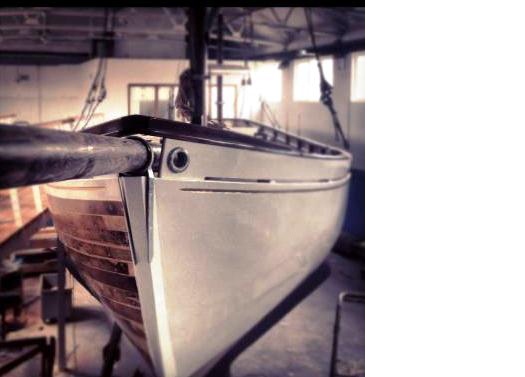
Asgard I pictured above, Celtic Mist in main image
Two boats, part of the Irish maritime scene in years past, are back in public – Asgard 1 and Celtic Mist – one ashore, the other afloat.
I was in the National Museum at Collins Barracks in Dublin when the historic ketch of Erskine and Mollie Childers went on exhibition after a five-year restoration project. It will be a permanent reminder of how the marine sphere was central to the formation of this Republic. Asgard looks superb. There was a lot of controversy over whether she should be restored or put to sea again, but the right decision has been made to conserve her ashore. The exhibition is open free-of-charge and worth seeing.
The second vessel, Celtic Mist, is the motor-sailing ketch of Charlie Haughey which his family donated to the Irish Whale and Dolphin Group. I was asked to re-dedicate it to its new role as a research vessel and did so on Sunday at Kilrush Marina, where hundreds watched the ceremony. I talked to Conor Haughey who told me: "They have rejuvenated her. She was getting old and tired and it would have been a shame if she rotted away rather than going to sea again. The boat was very important to my father. It has great family memories."
Onboard, Charles Haughey's cabin has been dismantled, including the bath and double berth and several bunks built instead for researchers who will track whales and dolphins and carry out other maritime research. Much of the eight-month refurbishment work was done by IWDG volunteers, with some contractors and financial assistance from the Clare Leader organisation and other supporters.
Despite all the controversy surrounding Haughey, as IWDG Director Simon Berrow said, getting the boat was a major benefit and came in the 21st year of its existence. In government Haughey had declared Ireland's waters a whale and dolphin sanctuary and Dr.Berrow said this should be followed by a
similar "pan-European designation" of EU waters. The Celtic Mist will provide a platform for finding out more about whales and other marine life off Ireland, he said.
JOHN TWOMEY AND THE IRISH PARALYMPIAN SAILORS
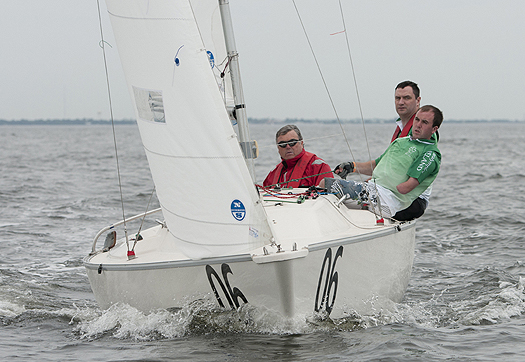
Irish Sonar Team
Kinsale Yacht Club member John Twomey is leading his crew into his tenth consecutive Paralympics, a magnificent achievement for the 57-year-old sailor. He will Skipper the Sonar, Ireland's only sailing entry, with crew Anthony Hegarty and Ian Costelloe. Sailing will be in the testing waters of Weymouth Bay on the south coast of England where the Olympic events were also held.
For the past three and a half decades he has been one of Ireland's most consistent and successful performers at the Paralympic Games. John is already the holder of Paralympic medals, won prior to his sailing career in the discus event - bronze in 1984 and gold at Seoul 1988. He also competed in table tennis before his transition to sailing, winning silver in the team event at Arnhem in 1980. Before moving to the three-man Sonar keelboat he sailed with Amy Kelleher in the mixed SKUD18 event at Beijing 2008, finishing tenth with a score of 75 points.
In preparing for this year's Paralympic John, Anthony and Ian were 7th in the World Disabled Sailing Championships in Florida and have been practising intensively off Kinsale over the past few weeks.
I met him at Kinsale YC and he was hopeful about their prospects:
"Tough waters in Weymouth, but with the experience of the past few months, particularly in the world championships we are well prepared."
John is from Ballinhassig, has represented Ireland more times than any other Olympic or Paralympic athlete. He is involved in sailing courses in Kinsale for people with disabilities where up to 30 sailors with a wide range of physical, intellectual and sensory disabilities go sailing every Saturday.
In Paralympic Sailing, three medal events feature one, two and three sailors per boat, respectively. All events consist of nine separate races with one point for first, two for second and so on, the same as in Olympic sailing. The winner has the lowest points total at the end of the nine races.
John's crew mates are 42-year-old Anthony from Mallow and 24-year-old Ian from Killorglin in County Kerry. Both are both amputees. John introduced Anthony to sailing seven years ago. He works as a software developer for Core International and has represented Ireland on several occasions. He is also a member of Kinsale Yacht Club.
Ian also sails out of Kinsale YC and will be making his first appearance at the Paralympic Games.
Paralympics Ireland CEO and Chef de Mission for the Irish Team, Liam Harbison, said there has been tremendous preparation, co-ordination and management of the Irish Team. "It's time for us to make a return on the faith and investment placed in us – we aim to deliver."

From left: John Twomey, Ian Costelloe and Anthony Hegarty.
NEW PILOT BOAT IN CORK
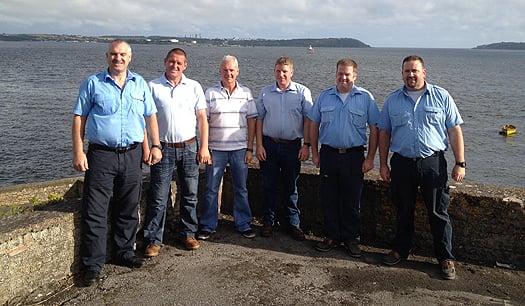
Cork Pilot Boat Crew
Cork Port has a new pilot boat. 'Failte' was built by Safehaven Marine and replaces 'Sonia' which has been in service for 14 years. Safehaven Marine is a Cork -based company, employing 25 staff in Little Island and Youghal. Since the company was founded in 1998. They have supplied pilot boats to countries from Scandinavia to the Middle East and are one of Europe's leading manufacturers of GRP pilot boat.
There are eight full-time crew, six of them pictured here – L to R: Ron Randalls, Carl Randalls, Gerry Moran, George Norris, Con Crowley and Keith Ryan. (Two were on holiday when the photo was taken.) The boat is an Interceptor 48 with two Volvo D13 engines, 600 hp each.
Cork pilot boats undertake in excess of 3,000 services per annum to vessels of all types including cruise ships and cargo vessels, according to the port company.
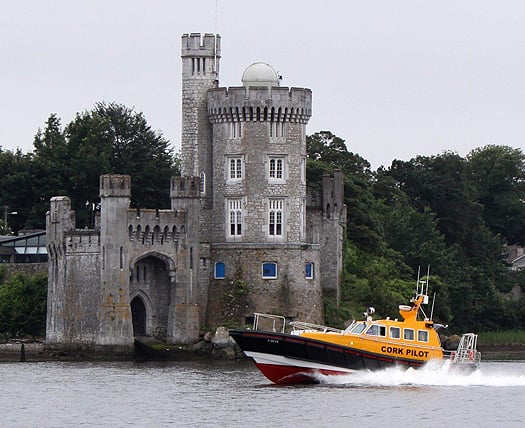
MAKING PILOTING SAFER
The International Maritime Pilots' Association and the International Chamber of Shipping have joined forces to update a brochure aimed at shipping companies and seafarers to ensure that ladders used for pilot transfers are safe and always rigged correctly.
The revised brochure – 'Shipping Industry Guidance on Pilot Transfer Arrangements' – is supported by a wide range of other international shipping bodies. It takes account of the latest amendments to the Safety of Life at Sea Convention (SOLAS) concerning pilot ladders, which came into effect on 1 July 2012.
IMPA Secretary General, Nick Cutmore, said: "Pilots continue to lose their lives as a result of accidents while boarding or disembarking from ships, and many more have been seriously injured."
ICS Secretary General, Peter Hinchliffe, added: "Some common causes of accidents still appear to be defects in the structure of the ladder treads or ropes, or a lack of a proper securing of the ladder to the ship."
An electronic copy of the IMPA/ICS brochure can be downloaded from the IMPA and ICS websites.
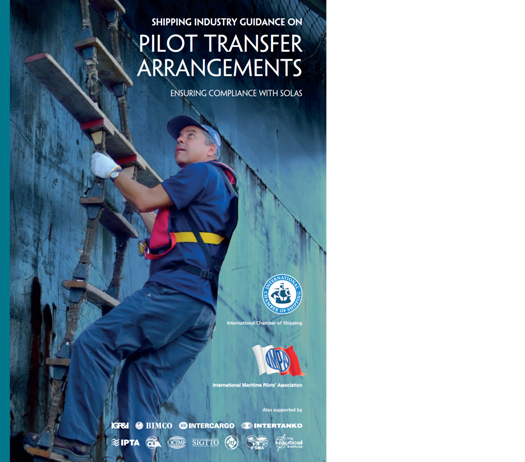
New Pilot Boarding Advice
--------------------------------------------------------------------------------------------------------
Email your comments on items in TIN develop maritime discussion to: [email protected]
Follow me for more maritime news and comment on Twitter: @TomMacSweeney
And on Facebook – THIS ISLAND NATION page
Irish Sailors Fight for Medal Race Rights in Miami
#MOCR – A place in this weekend's medal race is the likley prize for Olympic Star keelboat pair Peter O'Leary and David Burrows who have scored top ten results for the third day in a row at the Miami Olympic Classes Regatta. The Cork–Dublin duo, now in seventh overall after a seventh and a sixth scored yesterday, need to continue the consistent performance into today's final round of fleet racing to secure a top ten placing overall.
Dun Laoghaire's single-hander Annalise Murphy in the Laser Radial now in ninth overall is also set for a place in Saturday's medal race having discarded her worst result of 27th, scored yesterday afternoon on Biscayne Bay.
The Irish Paralympic team in the Sonar class had their best day so far of the championship with two fifth places. A protest yesterday evening resulted in their disqualifcation from yesterday's final race but that didn't prevent them from moving up one place on the leader board to seventh overall.
Laser sailor James Espey from Belfast Lough slipped to 22nd overall following two 35th places.
Additional reporting by organisers:
Miami, Florida, USA: A final showdown awaits three Paralympic classes tomorrow and ten Olympic classes on Saturday at US Sailing's Rolex Miami OCR, which has, thus far, gifted sailors with four days of sublime sunshine and satisfying winds. The event is the only one of seven ISAF Sailing World Cup events to grace a shore on this continent and has attracted 529 sailors from 41 countries from as close as Canada and as far away as New Zealand and China.
"It's looking pretty exciting," said Brazil's Star sailor Robert Scheidt, who with crew Bruno Prada has perhaps one of the most impressive sailing records here. (Together, they are two-time Olympic medalists and just off their second straight title win at the Star World Championships). "Some of the guys who have already got a spot in the Olympics are here and they are really sailing well."
No one has been proving that theory better than Sweden's Fredrik Loof/Max Salminen who yesterday trailed Scheidt/Prada by two points and today tied on points with the Brazilians after finishing 6-2 to their 3-7. With both teams posting 26 points, Norway's Eivind Melleby/ Petter Moerland Pedersen are nipping at their heels with only 29 points.
As will happen at the Olympics, only the top-ten boats after tomorrow's racing will be allowed to progress to Saturday's single medal race, which will determine gold, silver and bronze medals.
For the Paralympic sailors here, tomorrow will be the final day of racing (two races each scheduled for Skud-18, Sonar and 2.4mR classes) and determine who takes home medals. (This is the same format that will be followed at their Games.)
Top three podium positions:
Sonar, 10 boats, - 8 races
1. Jourden Bruno / Vimont Vicary Nicolas / Flageul Eric, FRA, 19 points
2. Udo Hessels / Marcel van de Veen / Mischa Rossen, NED, 20
2. John Robertson / Hannah Stodel / Steve Thomas, GBR, 22
Star, 29 boats, - 8 races
1. Robert Scheidt / Bruno Prada, BRA, 26
2. Fredrik Loof / Max Salminen, SWE, 26
3. Eivind Melleby / Petter Moerland Pedersen, NOR, 29
49er, 23 boats, - 12 races
1. Nico Luca Marc Delle Karth / Nikolaus Resch, AUT, 29
2. Erik Storck / Trevor Moore, USA, 33
3. Allan Norregaard / Peter Lang, DEN, 61
Skud-18, 6 boats, - 8 races
1. Daniel Fitzgibbon / Liesl Tesch, AUS, 13
2. Alexandra Rickham / Niki Birrell, GBR, 13
3. Jennifer French / Jean-Paul Creignou, USA, 20
2.4mR, 25 boats, - 8 races
1. Damien Seguin, FRA, 13
2. Paul Tingley, CAN, 33
3. Megan Pascoe, GBR, 39
Laser Radial, 60 boats, - 8 races
1. Lijia Xu, CHN, 19
2. Marit Bouwmeester, NED, 25
3. Evi Van Acker, BEL, 38
470 Men, 22 boats, - 8 races
1. Mathew Belcher / Malcolm Page, AUS, 20
2. Sven Coster / Kalle Coster, NED, 24
3. Lucas Calabrese / Juan Maria de la Fuente, ARG, 32
470 Women, 15 boats, - 8 races
1. Lisa Westerhof / Lobke Berkhout, NED, 22
2. Hannah Mills / Saskia Clark, GBR, 23
3. Maria Fernanda Sesto / Consuelo Monsegur, ARG, 31
Laser, Gold,, 37 boats,- 8 races
1. Paul Goodison, GBR, 15
2. David Wright, CAN, 17
3. Bruno Fontes, BRA, 18
Laser, Silver,, 37 boats,- 8 races
1. Marcin Rudawski, POL, 100
2. Ricardo Montemayor, MEX, 103
3. Matthew Ryder, CAN, 114
Finn, 25 boats, - 8 races
1. Zach Railey, USA, 9
2. Jonas Hogh Christensen, DEN, 19
3. Brendan Casey, AUS, 25
RS: X Men, 14 boats, - 8 races
1. Nick Dempsey, GBR, 7
2. Elliot Carney, GBR, 19
3. Mariano Reutemann, ARG, 20
RS: X Women, 12 boats, - 6 races
1. Demita Vega De Lille, MEX, 10
2. Carolina Mendelblatt, POR, 21
3. Farrah Hall, Annapolis, Md., USA, 22
Women's Match Racing
TOP FOUR ADVANCING TO SEMIFINALS
Sally Barkow / Alana O'Reilly / Elizabeth Kratzig-Burnham, USA, 3 wins- 0 losses
Silja Lehtinen / Silja Kanerva / Mikaela Wulff, FIN, 3 wins- 0 losses
Olivia Price / Nina Curtis / Lucinda Whitty, AUS, 3 wins- 0 losses
Lucy Macgregor / Annie Lush / Kate Macgregor, GBR, 3 wins- 2 losses
Irish Paralympic Team Making a Splash at IFDS Worlds
#PARALYMPICS - Irish team members John Twomey, Anthony Hegarty and Ian Costello are making waves at the World Championships for disabled sailors in Florida this week.
Inside World Parasport reports that the trio from Kinsale Yacht Club are tied for the top spot in the Sonar class, ahead of Norway and France, in the International Association for Disabled Sailing (IFDS) event at Laishey Park Marina.
As previously reported on Afloat.ie, Twomey and his crew have already qualified for the London Paralympics this summer after claiming one of the few rwmaining spots at the IFDS Worlds in Weymouth last July.
Kinsale Spring Sailing Photos
Bob Bateman was afloat today to capture the latest Spring sailing off Kinsale Yacht Club, a month long sailing series that has been sailed in sunshine so far each Sunday and today's Bank holiday Monday race was no different. Scroll down for photos, there are some nice shots of John Twomey's Sonar, Shillelagh.
Today's racing was sailed in a north east 8 knot breeze. An ebb tide flowing out of Kinsale harbour gave a good beat on the windward/leeward course, leaders tacking up the western shore.
The first round the weather mark was Anchor sailed by Ian Travers with sailmaker Nigel Young on board.
Winds dropped during the day but filled in again from the South East.
Classes 0, 1, 2 were on a round the cans course taking the Bullman buoy as weather mark before going on a two sail reach to Sovereigns Islands and a run out to SE mark.
Racing co ntinued all day and a weary class 2 only returned to the harbour after 5pm.
Racing concludes next saturday followed by a prize giving Dinner.
Photography from 2007 Soveriegn's Cup
A remarkable performance throughout all 8 races by John Twomey and his team aboard Shillelagh resulted in a clear victory in division 3 IRC by a margin of some 12 points to swoop the coveted Sovereign's Cup.
Dave O'Sullivan served as Regatta Director for Sovereigns Cup 2007 in Kinsale Yacht Club.
Bob Bateman's photos of Sovereign's Cup 2007 are BELOW.


























